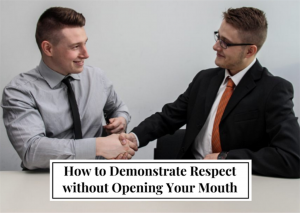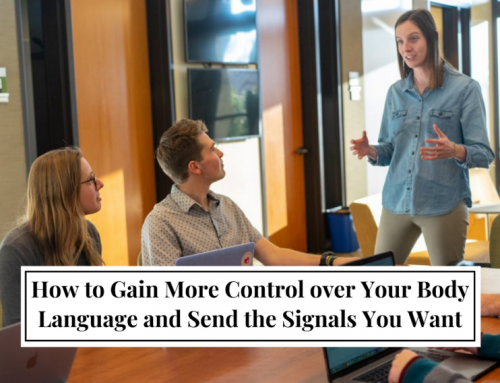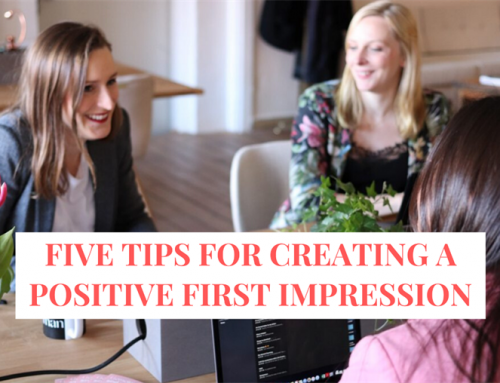According to anthropologist Edward T. Hall, up to 60 percent of all human communication is non-verbal. Understanding this fact will help you learn how you can demonstrate respect to others without ever opening your mouth. This is a great skill to learn because the more you listen and the less you speak, the more people respect you and perceive you as intelligent, helpful and creative.
Make Eye Contact
Eye contact is really tricky. You want to make eye contact but you don’t want to stare crazily at people and make them feel uncomfortable. They say that the eyes are the windows to the soul and it is true that you can tell a lot about a person by looking them in the eye.
In a group situation, always make eye contact with the person speaking, and then generously spread around the eye contact as people respond to the speaker. When listening, it’s good to break eye contact every four to six seconds so that the person doesn’t feel creeped out by your gaze.
In a one-on-one situation, if someone is talking a long time you can look at their mouth part of the time and they’ll feel more comfortable. Try looking at their mouth, each eye, their hair, and moving your gaze around but focus mostly on listening to what they are saying.
Learn to Shake Hands Properly
When you first meet someone, usually people shake hands. Some people get really carried away and shake too hard. Some larger men have even been known to draw blood when shaking a woman’s hand when she’s wearing rings. Some people, often women, tend to shake hands too lightly with a very limp wrist. This can feel kind of like shaking hands with a wet noodle and is very unappealing.
Both ways of hand shaking can make the person look less than confident. One is over-compensating and one is downplaying their importance. Both have bad reactions from others and neither should be continued. Both men and women should shake hands in essentially the same way.
To shake hands properly, look the person in the eye, put out your right hand, grasp the offered hand firmly but don’t squeeze hard. Pump your hand up and down three or four times and that’s it. Mind whose hand you’re shaking, too. If it’s an elderly person or a small person, don’t squeeze as hard. When appropriate it’s okay to do the double handshake where you enclose their hand in yours with both hands.
Keep Your Body Posture Open
Sometimes it can be hard to know what to do when you’re standing there without a podium or anything to protect you. Your arms feel heavy and you do the worst thing ever – you put your hands in your pockets or you cross your arms, thus hiding your hands. Try to stand with an open posture with your hands to your side so that you can use them freely for gesturing.
Showing your palms to others is akin to a dog showing his belly to show submissiveness. It’s a sign of respect and when you show respect to others you’ll get respect in return.
Do What You Say You’ll Do
No talking needed to follow up and do what people expect you to do. Doing what you told people you’ll do is one of the most important things you can do to show your respect for people. What’s great about this is that it really doesn’t require anything extra out of you, just sticking to your promises. Remember to always under promise and over deliver and you’ll always manage to accomplish this.
Lean in to Show Interest
When someone is talking, instead of leaning away and doing something else like checking a text message, get rid of the technology, lean in and truly listen to what the person is saying. Listen with your ears, your eyes and your body language by leaning toward the speaker a little.
Smile Comfortably
Always smile at people when you greet them and when they are talking as you’re listening – unless, of course, they’re talking about something sad or horrible. Be sensible in your smiling so you don’t look crazy. You don’t have to smile in a huge way; just turn the corners of your lips up a bit and put a smile in your eyes as you listen.
Face People Who Are Speaking to You
When someone is speaking, it’s important that you face them as they speak. Turing your back, looking around, looking at electronics, and doing something other than facing the speaker will look disrespectful.
Acknowledge “Comfort Zones”
People have different comfort zones for personal space, but in general it’s about 30 inches. Keep that in mind when you’re standing in a group, leaning in, or you’re conversing with people. Staying in their space too long will make the person uncomfortable and feel disrespected.
Keep in mind that these suggestions assume American, Canadian or Western ideas of respect. If you are dealing with other cultures, be sure to look into what different gestures mean by simply typing in the name of the country, and “gestures” to a search engine. Don’t underestimate the power that these suggestions will have on your interactions with others.







Leave A Comment